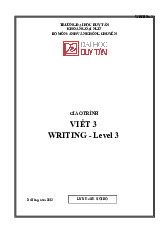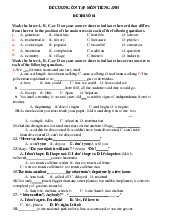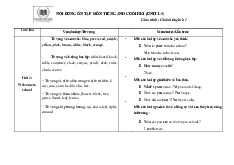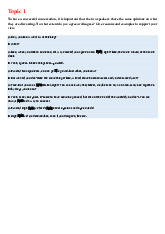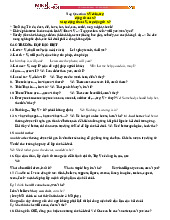













Preview text:
lOMoAR cPSD| 46836766
Table 3.1. The person analytical framework Person Vietnamese English First Tôi, tao, tớ, mình... I Singular Second
Mày, bạn, cậu, mi, ngươi,.... You pronouns Third
Nó, anh ấy, cô ấy, hắn, gã.... He, She, It
Chúng ta, chúng tôi, chúng First tớ,... We Plural
Chúng mày, bọn mày, bọn Second You pronouns mi,... Third
Chúng nó, bọn nó, tụi nó,... They
Table 3.2. The number of pronouns framework
- English includes 13 pronouns used in addressing (noun and counterpoint), and
Vietnamese has no official statistics. The number of personal pronouns varies in
many documents, with one author claiming that there are 20 personal pronouns,
another author claiming that there are 23 personal pronouns….
For example: In Vietnamese, when talking about yourself, we often use the words:
“Tôi, em, tớ, con, cháu, mình”, in English, only one word is used, "I". Or to say
“bọn họ, chúng, chúng nó, tụi nó” then in English only use "they".
- Regarding the pronouns indicating positions and occupations: in English, the
position or profession is mainly used in speech while in Vietnamese, it is used
in the imperative structure in speech and in sentences.
- Tiếng Anh có 13 đại từ dùng trong xưng hô (danh từ và đối ngữ), tiếng Việt chưa
có thống kê chính thức. Số lượng đại từ nhân xưng ở nhiều tài liệu khác nhau,
có tác giả cho rằng có 20 đại từ nhân xưng, tác giả khác cho rằng có 23 đại từ nhân xưng…. lOMoAR cPSD| 46836766
Ví dụ: Trong tiếng Việt, khi nói về bản thân, chúng ta thường dùng các từ: “Tôi, em,
tớ, con, cháu, mình” thì trong tiếng Anh, chỉ dùng một từ duy nhất là “I”.
Hoặc nói “bọn họ, chúng nó, chúng nó, lũ nó” thì trong tiếng Anh chỉ dùng “they”.
- Về đại từ chỉ chức vụ, nghề nghiệp: trong tiếng Anh, vị trí hay nghề nghiệp chủ
yếu được dùng trong khẩu ngữ, còn trong tiếng Việt, nó được dùng trong cấu
trúc mệnh lệnh trong khẩu ngữ và trong câu. lOMoAR cPSD| 46836766
Table 3.3. The semantic field of kinship terms framework Vietnamese English Tổ tiên, ông bà Ancestor Ông bà cố great-grandparent Ông cố great – grandfather Bà cố great – grandmother Ông bà grandparents Ông nội/Ông ngoại grandfather Bà ngoại/Bà nội grandmother Bố father Mẹ mother Bố vợ/ Bố chồng father – in- law Mẹ vợ/ Mẹ chồng mother – in – law Dì aunt Thím aunt Cô aunt Mợ aunt Chú uncle Bác uncle Dượng uncle Cậu uncle Anh/chị em ruột sibling Anh em trai brother Chị em gái sister Anh em họ cousin Anh/chị con bác first cousin
Chị dâu, Em dâu, Chị chồng, Em sister-in-law chồng, chị vợ, em vợ
Anh rể, em rể,anh chồng,em brother-in-law chồng,anh vợ,em vợ Con cái children Con gái daughter Con trai son Con dâu daughter-in-law Con rể son-in-law Cháu gái niece Cháu trai nephew Cháu nội/ Cháu ngoại grand-children
Cháu nội gái/Cháu ngoại gái granddaughter lOMoAR cPSD| 46836766
Cháu nội trai/Cháu ngoại trai grandson
Table 3.2. The influence of possible factors on the choice of family addressing terms analytical framework Factors English Vietnamese Age gap ( between 2 persons) Education I-You Financial power Mood Occasion Occupation Personality Position
Table 3.2. Family addressing terms analytical framework Addressing terms English Vietnamese categories
Title Mr.; Mrs.; Ms.; Dr.; Ông, bà, cô, giáo sư, bác
Professor; Madam, Boss sĩ, sếp,…
Title with full names Dr. James Smith, Mrs. Chủ tịch Hồ Chí Minh, Hillary Clinton, Ms. Tổng bí thư Nguyễn Phú Karen Jones Trọng Full name
Barack Hussein Obama, Phan Bội Châu, Hồ Chí Donald John Trump, Minh, Võ Nguyên Giáp Elizabeth Alexandra Mary First name James, Hillary, Karen Mai, Linh, Giang
Term of endearment Buddy, honey, babe, Bạn yêu, anh/em yêu, bé lOMoAR cPSD| 46836766 sweetie,… yêu, bé Kinship term
Father, mother, aunt, Bố, mẹ, cô, dì, chú, bác,… uncle,…
Kinship terms with first Aunt Susan, uncle Tom, cô Tuyết, chú Phong,… name … Nicknames Bee, Tony, Tommy,… Thóc, Gạo, Thỏ, Bi,… lOMoAR cPSD| 46836766
Family addressing terms in English often follow a hierarchical structure. Here are some com mon
terms used to address family members: - Parents : lOMoAR cPSD| 46836766
- Father (Dad, Daddy, Papa ) - Mother (Mom,
Mommy, Mama ) - Grandparents :
- Grandfather (Grandpa, Gramps, Poppy ) -
Grandmother (Grandma, Granny, Nana ) - Siblings :
- Brother (Bro ) - Sister (Sis ) - Children : - Son (Sonny, Junior )
- Daughter (Dottie, Princess ) - Uncles and Aunts :
- Uncle (Unc, Uncle [First Name ]) - Aunt (Auntie,
Aunt [First Name ]) - Cousins :
- Male: Cousin [First Name], Cousin Bro -
Female: Cousin [First Name], Cousin Sis - In- laws : - Father-in-law (Dad-in-law ) - Mother-in-law (Mom-in-law )
- Brother-in-law (Brother-in-law [First Name ])
- Sister-in-law (Sister-in-law [First Name ])
It's important to note that the specific terms used may vary depending lOMoAR cPSD| 46836766 lOMoAR cPSD| 46836766 BÀNG HỆ (HỌ BÊN NỘI) lOMoAR cPSD| 46836766 lOMoAR cPSD| 46836766 lOMoAR cPSD| 46836766 lOMoAR cPSD| 46836766 lOMoAR cPSD| 46836766
